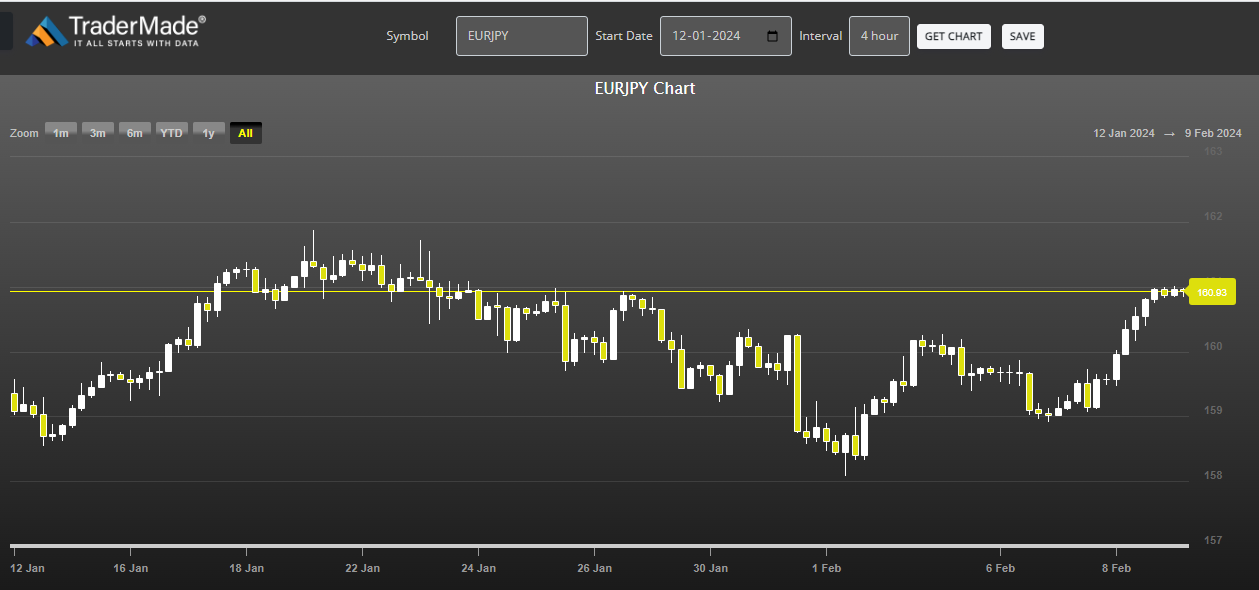
Yen Dips To a 10-Week Low
London: 9 February 2024 (TraderMade): The EURJPY currency pair stumbled below the psychological mark of 161.00 on Friday, succumbing to two main forces. Firstly, German Harmonized Index of Consumer Prices (HICP) data came in line with expectations, showing a 3.1% YoY increase in January.
The EURJPY pair surged 1.79% to 160.9055 (compared to its 1 February Low).
Key Takeaways
- Yen hit a 10-week low against USD due to hawkish Fed and dovish BoJ.
- Vulnerable as investors anticipate delayed BoJ rate hikes.
- Euro and Sterling are resilient despite central bank pushback.
- Risk appetite still plays a role, as seen with NZD rally.
- Mixed signals and data dependence cloud the outlook for major currencies.
- Upcoming data releases and central bank speeches key to watch.
- Will BoJ dovishness and Fed hawkishness define the market, or will surprises emerge?
EURJPY Trajectory: A Recent Rollercoaster Ride
The EURJPY currency pair has embarked on a somewhat volatile journey over the past few weeks, reflecting broader market forces and shifting sentiment.
From Strength to Weakness: On 19 January 2024, the pair closed at a relatively strong position of 161.4545, potentially fueled by optimism about the Eurozone's economic prospects.
Downward Slide: However, by 1 February 2024, the pair had slipped significantly to 159.19, marking a 1.4% decline. This dip could be attributed to various factors, including dovish comments from the European Central Bank (ECB) dampening rate hike expectations, or concerns about geopolitical tensions impacting the Eurozone.
Recent Stabilization: As of today, 9 February 2024, the live mid-market rate stands at 160.985, indicating a slight recovery from the February 1st low. This could be due to temporary risk-off sentiment driving demand for the Euro as a safe haven, or perhaps market participants awaiting further clarity on key data releases or central bank policies.
Overall: While the current level is closer to where it was two weeks ago, the EUR/JPY pair has undeniably experienced some turbulence. The future trajectory remains uncertain and will likely hinge on factors such as upcoming economic data, ECB and BoJ monetary policy decisions, and the global risk environment.

When will ECB Cut and BoJ Rise Rates?
This moderate inflation print offered little impetus for further tightening by the European Central Bank (ECB), potentially dampening the appeal of the Euro (EUR). Secondly, dovish remarks from Bank of Japan (BoJ) officials cast a shadow over the Yen (JPY).
BoJ Deputy Governor Shinichi Uchida and Governor Kazuo Ueda both downplayed expectations of aggressive rate hikes even after ending negative interest rates, fueling speculation about prolonged accommodative policies in Japan. This juxtaposition of central bank stances weakened the Yen and weighed on the EUR/JPY cross.
Yen Hits 10-Week Low as Dollar Shines Brighter
The Japanese Yen faced additional headwinds, plummeting to its lowest point against the US Dollar (USD) in ten weeks. This slide can be attributed to two key factors. Firstly, traders are adjusting their rate hike expectations for major central banks, particularly the Federal Reserve (Fed).
Strong US labor market data and hawkish comments from Fed Chair Jerome Powell led to a retreat from early rate cut bets, boosting the Dollar's appeal. Secondly, the perceived dovishness of the BoJ compared to the Fed further amplified the Yen's weakness. With investors anticipating a delayed start to BoJ tightening, the Yen lost ground as a safe-haven asset.
Euro and Sterling Hold Their Ground Despite Central Bank Pushback
While the EURJPY and Yen struggled, the Euro (EUR) and Sterling (GBP) displayed relative resilience. Despite pushback from both the ECB and Bank of England (BoE) against market expectations of early rate cuts, these currencies held their ground.
This suggests that investors may be placing greater weight on regional economic fundamentals and geopolitical factors when assessing these currencies. Notably, New Zealand's Dollar (NZD) even rallied on optimism about the strength of its labor market, indicating that risk appetite can still influence currency movements.
Uncertain Path Ahead: Mixed Signals and Data Dependence
The outlook for major currencies remains shrouded in uncertainty as markets navigate a complex tapestry of central bank policies, economic data, and geopolitical developments. The recent dip in the EUR/JPY and weakness in the Yen highlight how different central bank stances can impact currency dynamics.
However, currencies like the Euro and Sterling demonstrate the influence of other factors beyond monetary policy. Traders will be closely monitoring key data releases, including the US Consumer Price Index (CPI) next week, and central bank speeches for further direction.
The question remains: Will the dovish BoJ and hawkish Fed continue to shape the currency landscape, or will upcoming data surprises or geopolitical shifts alter the course? Only time will tell.


